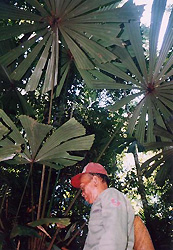(3) Ethnobotanical knowledge and plant specimens were collected to complement an inventory of Penan Benalui ethnobotanical knowledge studied during the previous fieldwork. The inventory includes information on Penan Benalui names and usage of plants. The Penan Benalui proved to have abundant and in-depth plant names. They reported as many useful plants as agricultural groups in Borneo. However, they use fewer plants for medicinal and ritual purposes than the agricultural groups.
The learning process for ethnobotanical knowledge differs among individuals, but they usually begin learning from their parents when they become old enough to remember what they are taught (late teenager or older). Personal experiences also play an important role in the learning process. Differences of habitat, ecology, and qualities among closely related plants are mostly leaned through personal observations.
There were some young men who had deep knowledge of forest plants, but there were no young women who did. Men still frequently go into the forests for hunting and gathering, while women spend most of their time in the village.

 21st Century COE Program
-Aiming for COE of Integrated Area Studies-
21st Century COE Program
-Aiming for COE of Integrated Area Studies-